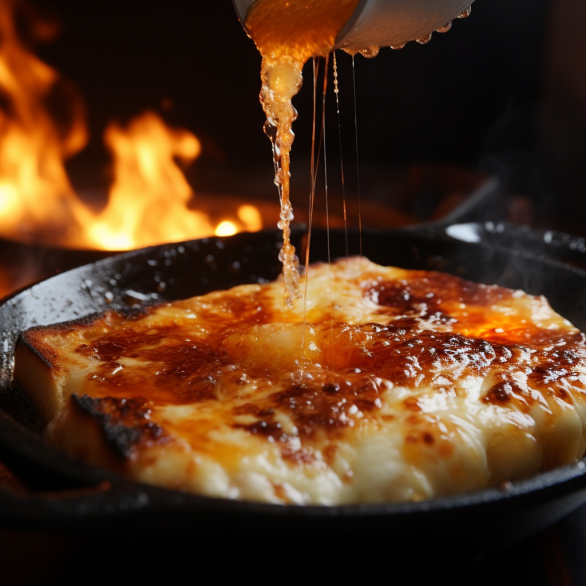Introduction to Greek Saganaki Recipe
Saganaki Recipe is a popular Greek dish made with fried cheese. It is often served as an appetizer or meze, a small dish meant to be shared.The dish gets its name from the small, two-handled frying pan called a saganaki or sagani in which it is traditionally cooked. Greek restaurants are the best places to find saganaki, as they specialize in serving authentic Greek cuisine. If you’re looking to try saganaki, you can use online restaurant directories or food delivery apps to find Greek restaurants near you.
Saganaki is typically made with kefalotyri or graviera cheese, which have a firm texture that holds up well to frying. The cheese is first covered with cold water to prevent it from sticking to the pan. It is then dredged in flour, coated evenly, and pan-fried in olive oil until it becomes golden and crispy on both sides. The result is a deliciously melted cheese with a crispy outer crust. While flambéing saganaki is not commonly done in Greece, it can be a matter of personal taste and preference.
Saganaki is a dish that showcases the wonderful flavors and textures of Greek cuisine. It is a simple yet delicious way to enjoy cheese, and it pairs perfectly with a squeeze of lemon and crusty bread. The combination of the tangy lemon, the richness of the cheese, and the crunch of the bread creates a delightful culinary experience.
What is Saganaki?
Saganaki is a traditional Greek appetizer that consists of cheese cooked in a saganaki or sagani frying pan. The most common traditional Greek saganaki recipe is made with cheese and served as a starter alongside dishes like moussaka. The traditional Greek cheeses used for saganaki are graviera, kefalograviera, and kefalotyri. These cheeses have a firm texture that holds up well to frying. However, alternative cheeses like Monterey Jack, provolone, and young Pecorino can also be used to create unique variations of saganaki.
To prepare saganaki, the cheese is first covered with cold water and then dredged in flour. This helps create a crispy crust when the cheese is fried. The cheese is then pan-fried in olive oil until it becomes golden and crispy on both sides. This cooking method ensures that the cheese melts and becomes gooey on the inside, while the outside develops a deliciously crispy texture. Once cooked, the saganaki is served hot with a squeeze of lemon, which adds a refreshing tang to complement the richness of the cheese. While flambéing saganaki is not commonly done in Greece, it can be a matter of personal taste and preference.

Saganaki is a versatile dish that can be enjoyed on its own as an appetizer or incorporated into other recipes. For example, saganaki can be added to a Greek salad to create a flavorful and satisfying main course. The creamy, melted cheese pairs perfectly with the fresh vegetables and tangy dressing of the salad. Saganaki can also be served alongside grilled meats or as part of a meze platter, which is a selection of small dishes meant to be shared. Whether enjoyed as a standalone dish or as part of a larger meal, saganaki is sure to delight your taste buds.
Finding Saganaki Near You
If you’re looking to enjoy saganaki at a restaurant, Greek restaurants are the best places to find this delicious dish. These establishments specialize in serving authentic Greek cuisine and often have saganaki on their menu. To find Greek restaurants near you, you can use online restaurant directories or food delivery apps. These platforms allow you to search for Greek cuisine specifically and provide information about the restaurants in your area that serve saganaki.
Chef on a Bike is a website that offers a wealth of information and resources for exploring Greek cuisine. From traditional recipes to regional specialties, the website provides a comprehensive guide to Greek cooking. It also offers tips and techniques to help you recreate authentic Greek flavors at home. Whether you’re looking for a restaurant that serves saganaki or want to try making it yourself, Chef on a Bike can be a valuable resource. Their website provides detailed instructions and tips to help you achieve the perfect saganaki at home.

How to Make Saganaki at Home
If you prefer to try making saganaki in the comfort of your own home, it is a relatively simple dish to prepare. Here are the steps to make saganaki at home:
- Start by choosing the cheese you want to use. Traditional Greek cheeses like graviera, kefalograviera, and kefalotyri work best, but you can also experiment with other varieties like Monterey Jack, provolone, or young Pecorino.
- Cut the cheese into thick slices or wedges, depending on your preference.
- Fill a bowl with cold water and place the cheese slices in it. Let them soak for a few minutes. This step helps prevent the cheese from sticking to the pan when you fry it.
- In a separate bowl, place some flour. Take each cheese slice out of the water and coat it in the flour, making sure to cover all sides.
- Heat a pan over medium-high heat and add a generous amount of olive oil. Once the oil is hot, carefully place the cheese slices in the pan.
- Fry the cheese slices until they turn golden and crispy on both sides. This should take a few minutes on each side.
- Once the cheese is cooked, remove it from the pan and place it on a plate lined with paper towels to absorb any excess oil.
- Serve the saganaki hot with a squeeze of lemon and crusty bread on the side. The lemon adds a tangy freshness that complements the richness of the cheese, while the bread provides a perfect vehicle for scooping up the melted cheese.
Feel free to experiment with different cheeses and flavors to create unique variations of saganaki. You can also add herbs, spices, or even a drizzle of honey to enhance the flavors. Chef on a Bike offers a collection of Greek recipes, including saganaki, that can provide inspiration for your culinary adventures [^1^]. The website provides detailed instructions and tips to help you achieve the perfect saganaki at home.
Saganaki Variations
While the traditional saganaki recipe uses cheese as the main ingredient, there are also variations of saganaki that incorporate other ingredients. One popular variation is shrimp saganaki. Shrimp saganaki is a Greek dish made with shrimp cooked in a spicy tomato sauce with feta cheese [2]. To make shrimp saganaki, a quick tomato sauce is made on the stovetop and then the shrimp is baked in the sauce with chunks of feta.The dish is finished by browning the feta under the broiler and sprinkling fresh mint on top before serving. This variation adds a delicious twist to the traditional saganaki recipe.
Another variation of saganaki is vegetable saganaki, which involves cooking a medley of vegetables in a similar manner to the traditional cheese saganaki. The vegetables are pan-fried until tender and then topped with cheese and herbs. This variation is a great option for vegetarians or those looking for a lighter alternative to the cheese-based saganaki.
Pairing Saganaki with Accompaniments
Saganaki is often served as an appetizer or meze, and it pairs well with certain accompaniments. A squeeze of lemon over the saganaki adds a tangy freshness that balances the richness of the fried cheese. Additionally, serving saganaki with crusty bread allows you to scoop up the melted cheese and enjoy it with the bread. Saganaki can also be enjoyed alongside a Greek salad or a green salad, as the crispness and freshness of the salad complement the flavors of the saganaki. Chef on a Bike offers recipes for Greek salads and accompaniments that can enhance your saganaki experience [^1^].
Greek cuisine is known for its use of fresh ingredients and vibrant flavors. When pairing saganaki with accompaniments, it’s important to consider the balance of flavors and textures. The tanginess of the lemon and the freshness of the salad help cut through the richness of the saganaki, creating a harmonious combination. Additionally, the crusty bread provides a satisfying contrast to the melty cheese, adding a delightful crunch to each bite. Experimenting with different accompaniments can further enhance your saganaki experience and allow you to discover new flavor combinations.
Health Benefits of Saganaki
While saganaki is a delicious dish, it should be enjoyed in moderation due to its calorie and fat content. The cheese used in saganaki provides beneficial nutrients such as calcium and protein. Calcium is essential for maintaining strong bones and teeth, while protein is important for building and repairing tissues in the body. However, it is important to incorporate saganaki into a balanced and healthy diet. Chef on a Bike features a range of healthy Greek recipes on their website that can help you enjoy Greek cuisine while maintaining a balanced lifestyle [^1^].
When enjoying saganaki, it’s important to be mindful of portion sizes and overall calorie intake. Saganaki is a rich and indulgent dish, so it’s best to savor it in moderation. Pairing it with a side salad or other lighter dishes can help create a more balanced meal. Greek cuisine offers a wide variety of nutritious options, including fresh vegetables, lean proteins, and whole grains. By incorporating these elements into your diet along with saganaki, you can enjoy the flavors of Greek cuisine while also maintaining a healthy lifestyle.
Exploring Greek Cuisine
Greek cuisine is renowned for its delicious flavors and healthy ingredients. Beyond saganaki, there are numerous other Greek dishes that you can explore and enjoy. Greek cuisine is characterized by its use of fresh herbs, olive oil, and a variety of vegetables, making it a great choice for those looking to incorporate more plant-based meals into their diet. Some popular Greek dishes include moussaka, souvlaki, spanakopita, and tzatziki.
Moussaka is a hearty casserole made with layers of eggplant or potatoes, spiced meat, and a creamy béchamel sauce. Souvlaki is a classic Greek street food consisting of skewered and grilled meat, usually served with pita bread and tzatziki sauce. Spanakopita is a savory pastry made with layers of flaky phyllo dough, spinach, and feta cheese. Tzatziki is a refreshing yogurt-based sauce flavored with cucumber, garlic, and dill, commonly served as a dip or condiment.
Chef on a Bike provides a comprehensive collection of recipes and information about Greek cuisine. From traditional dishes to breakfast and brunch options, grilled meat recipes, and more, the website offers a wealth of knowledge about the diverse flavors and unique dishes of Greek cuisine [^1^]. Exploring Greek cuisine can be a delightful culinary journey that introduces you to new flavors and techniques.
The Heritage of Greek Food
Greek food has a rich history and heritage, and saganaki holds cultural significance within Greek culinary traditions. Greek cuisine has been influenced by various civilizations throughout history, including the ancient Greeks, Romans, Byzantines, and Ottomans. Each of these influences has contributed to the unique flavors and ingredients found in Greek dishes.
The heritage of Greek food goes beyond just the recipes and ingredients. It is deeply intertwined with the culture and traditions of the Greek people. Many Greek dishes are associated with specific holidays or events, and they often play a central role in family gatherings and celebrations. For example, lamb is traditionally served during Easter, while melomakarona and kourabiedes are popular Christmas treats.
Chef on a Bike’s website offers insights and information about the origins and traditions associated with Greek cuisine [^1^]. Exploring the heritage of Greek food can provide a deeper appreciation for the flavors and techniques used in traditional Greek cooking. It can also offer a glimpse into the rich history and cultural significance of Greek cuisine.
Conclusion and Call to Action
Saganaki is a delicious and versatile Greek dish made with fried cheese. Whether you’re looking to enjoy saganaki at a Greek restaurant or try making it at home, there are numerous options available to satisfy your cravings. Visit Chef on a Bike at https://chefonabike.com/ for more Greek recipes, including variations of saganaki and other traditional dishes. Embrace the warmth of Greek culinary traditions and embark on a flavorful journey through Greek cuisine with Chef on a Bike as your guide. The website offers a wealth of resources and information to help you explore the vibrant flavors of Greek cuisine. From traditional recipes to tips and techniques, Chef on a Bike is your go-to source for all things Greek food. Start your Greek culinary adventure today and discover the joy of cooking and eating Greek cuisine.
Sponsored by
Digital Marketing Company Digital Heroes Caffe and Financial Navagator 360, this culinary adventure promises to tantalize your taste buds and provide insights into the culinary world of Greece.
Greek Mezes Recipe: Where Flavor Meets Tradition
Our exploration begins with Greek Mezes Recipe, a culinary hub that celebrates the heart of Greek cuisine. Mezes, the small plates of Greek gastronomy, are a testament to the country’s culinary heritage. Discover how these flavorful bites have become an integral part of Greek dining culture.
Dolmades: A Taste of Greece Wrapped in Grape Leaves
Dolmades, or Greek stuffed vine leaves, are a culinary masterpiece. Learn more about these savory parcels at Dolmades, where the art of dolmades-making is celebrated. Explore the intricate flavors and techniques that go into crafting this Greek delight.
YouTube Chef on a Bike: Your Culinary Companion
For those who seek a more hands-on approach, Chef on a Bike offers a treasure trove of authentic Greek recipes and interactive cooking sessions. Immerse yourself in the world of Greek culinary adventures guided by passionate Greek chefs.
Anna-Maria Barouh: A Culinary Journey
Behind every great culinary experience, there are dedicated individuals like Anna-Maria Barouh. Explore her culinary insights and expertise at Anna-Maria Barouh as she shares her passion for Greek cuisine and culture.
As we unravel the secrets of Greek Saganaki, we invite you to embark on this culinary voyage with us. Whether you’re a novice or a seasoned cook, our mission is to bridge the gap between tradition and innovation, and to immerse you in the comforting embrace of Greek flavors. Join us in celebrating the art of Greek cooking, where every stir, chop, and simmer carries the essence of a rich culinary tradition.


















